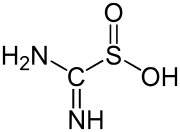Sulfinic acid
Sulfinic acids are oxoacids of sulfur with the structure RSO(OH). In these organosulfur compounds, sulfur is pyramidal.

They are often prepared in situ by acidification of the corresponding sulfinate salts, which are typically more robust than the acid. These salts are generated by reduction of sulfonyl chlorides.[1] An alternative route is the reaction of Grignard reagents with sulfur dioxide. Transition metal sulfinates are also generated by insertion of sulfur dioxide into metal alkyls, a reaction that may proceed via a metal sulfur dioxide complex. Unsubstituted sulfinic acid, when R is the hydrogen atom, is a higher energy isomer of sulfoxylic acid, both of which are unstable.
Examples
An example of a simple, well-studied sulfinic acid is phenylsulfinic acid. A commercially important sulfinic acid is thiourea dioxide, which is prepared by the oxidation of thiourea with hydrogen peroxide.[2]
- (NH2)2CS + 2H2O2 → (NH)(NH2)CSO2H + 2H2O
 Structure of "thiourea dioxide", a commercially useful sulfinic acid
Structure of "thiourea dioxide", a commercially useful sulfinic acid
Another commercially important sulfinic acid is hydroxymethyl sulfinic acid, which is usually employed as its sodium salt (HOCH2SO2Na). Called Rongalite, this anion is also commercially useful as a reducing agent.
Sulfinate
The conjugate base of a sulfinic acid is a sulfinate anion. The enzyme cysteine dioxygenase converts cysteine into the corresponding sulfinate. One product of this catabolic reaction is the sulfinic acid derivative hypotaurine.
References
- Whitmore, F. C.; Hamilton, F. H. (1922). "Sodium p-Toluenesulfinic Acid". 2: 89. doi:10.15227/orgsyn.002.0089. Cite journal requires
|journal=(help) - D. Schubart "Sulfinic Acids and Derivatives" in Ullmann's Encyclopedia of Industrial Chemistry 2012, Wiley-VCH, Weinheim. doi:10.1002/14356007.a25_461
External links
- Sulfinic+Acids at the US National Library of Medicine Medical Subject Headings (MeSH)
- Diagram at ucalgary.ca
- Diagram at acdlabs.com